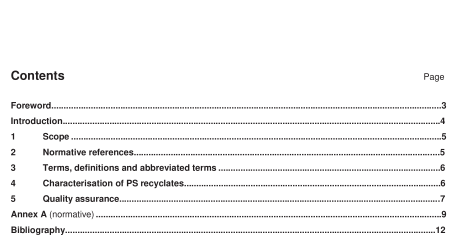BS EN 15342:2007 – Plastics — Recycled Plastics — Characterization of polystyrene (PS) recyclates

1 Scope
This European Standard defines a method of specifying delivery condition characteristics for polystyrene (PS) recyclates.
It gives the most important characteristics and associated test methods for assessing a single batch of PS recyclates intended for use in the production of semi-finished/finished products.
It is intended to support parties involved in the use of recycled PS to agree on specifications for specific and general applications.
This standard does not cover the characterisation of plastics wastes. See EN 1 5347.
This standard is applicable without prejudice to any existing legislation.
2 Normative references
The following referenced documents are indispensable for the application of this document. For dated references, only the edition cited applies. For undated references, the latest edition of the referenced document (including any amendments) applies.
EN 1 2099, Plastics piping systems — Polyethylene piping materials and components — Determination of volatile content
EN ISO 1 78, Plastics — Determination of flexural properties (ISO 178:2001)
EN ISO 1 79-1 , Plastics — Determination of Charpy impact properties — Part 1: Non-instrumented impact test (ISO 179-1:2000)
EN ISO 1 79-2, Plastics — Determination of Charpy impact properties — Part 2: Instrumented impact test (ISO 179-2:1997)
EN ISO 1 80, Plastics — Determination of Izod impact strength (ISO 180:2000)
EN ISO 306, Plastics — Thermoplastic materials — Determination of Vicat softening temperature (VST) (ISO 306:2004)
EN ISO 472:2001 , Plastics — Vocabulary (ISO 472:1999)
EN ISO 527-1 , Plastics — Determination of tensile properties — Part 1: General principles (ISO 527-1:1993 including Corr 1:1994)
EN ISO 527-2, Plastics — Determination of tensile properties — Part 2: Test conditions for moulding and extrusion plastics (ISO 527-2:1993 including Corr 1:1994)
EN ISO 1 1 33, Plastics — Determination of the melt mass-flow rate (MFR) and the melt volume-flow rate (MVR) of thermoplastics (ISO 1133:2005)
EN ISO 3451 -1 , Plastics — Determination of ash — Part 1: General Methods (ISO 3451-1:1997)
EN ISO 1 1 83-1 , Plastics — Methods for determining the density of non-cellular plastics — Part 1: Immersion method, liquid pyknometer method and titration method (ISO 1183-1:2004)
CEN/TR 1 5353:2007, Plastics — Recycled plastics — Guidelines for the development of standards for recycled plastics
3 Terms, definitions and abbreviated terms For the purposes of this European Standard, the terms and definitions given in EN ISO 472:2001 and CEN/TR 1 5353:2007 apply. The abbreviated terms are given in EN ISO 1 043-1 :2001 .
4 Characterisation of PS recyclates A single batch is the quantity of recyclate that has homogeneous characteristics within the specified tolerances. The characteristics of PS recyclates, which shall be determined for every batch of recyclate, are given in Table 1 , and are divided into two types: Required characteristics, needed to define PS recyclates in general, and required for all recyclates. Optional characteristics, needed to define PS recyclates according to customer specifications and applications.
NOTE Polystyrene, or polystyrene-containing, plastics wastes for recycling may contain a variety of styrenic polymers, such as General Purpose (crystal or expanded) PS, and Impact-modified PS (usually containing grafted rubber particles). There may also be copolymers containing α-methyl styrene, butadiene, isoprene, acrylonitrile etc., and there may even be other non-styrenic polymers. The properties and performance of recyclates derived from such wastes will depend on the relative proportions of those polymers. Some of these copolymers (MBS, SAN for example) are not miscible with polystyrene, and can have adverse effects on the recyclate properties.
BS EN 15342:2007 – Plastics — Recycled Plastics — Characterization of polystyrene (PS) recyclates